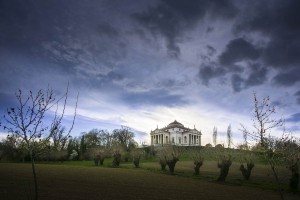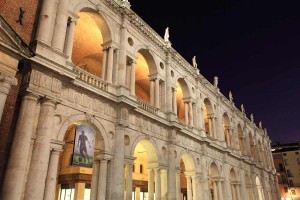Northern Italy’s most important Renaissance architect was born in Padua on 30 November 1508. Andrea di Pietro della Gondola, better known as Palladio, was the first full-time occupational architect of his time. Inspired by the Roman Age and other Renaissance architects, Palladio both put his work into theory and practice. Starting in 1540, he left a decisive mark on Vicenza and became the city’s most important master builder after having initially only worked on a few select villas in the surroundings. 23 of his buildings in the history city centre and another 24 villas in the Veneto were declared UNESCO World Heritage Site in 1994 and 1996. Time for a little trip down architectural memory lane.
About Andrea Palladio

©Bigstock.com/starmaro
Before letting you embark on a tour through Vicenza’s historic city centre, why not learn a little bit more about Andrea Palladio? Being the son of a miller, he was everything but destined to enjoy a major architectural career. Sculptor Vincenzo Grandi, Palladio’s godfather, sponsored him with an education as a mason and sculptor. He met Gian Giorgio Trissino in 1536. The poet and philosopher, 30 years his senior, immediately saw his gift, supported him and gave him the name Palladio. Trissino financed a very important trip to Rome allowing the master builder and architect-to-be to closely study Roman buildings.
It took until 1549 for Palladio to play a key role in Vicenza when his proposal to reconstruct Palazzo della Ragione won a contest. A meteoric rise followed occasionally even leading Palladio to Venice. His self-illustrated works about Roman and Renaissance architecture put him on the same theorist level as Leon Battisti Alberti and would decisively influence and inspire young master builders for decades and even centuries to come. Palladio passed away on 19 August 1580, four years before his final building, Teatro Olimpico, was completed.
Vicenza’s historic city centre

©Bigstock.com/mary416
You can find buildings that are at least attributed to Andrea Palladio at pretty much every corner of Vicenza’s historic city centre. The industrious Renaissance architect left behind a sizeable architectural heritage; his buildings that were milestones of their time now accompany your city tour. Here are three masterpieces you absolutely must visit.
Basilica Palladiana
After the main part of Palazzo della Ragione had partially collapsed in the late 15th century, it would take over 50 years until a new plan was eventually implemented. Palladio, then a complete unknown, was awarded the contract, but constructions were only finished 34 years after his years. Basilica Palladiana, as it is now known, received a completely new and prestigious look with white marble, triumphal arch pattern and a Venetian window. The almost identical layout and design of both floors was unusual for its time, particularly for public buildings. A look at the roof unearths the large council hall surrounded by allegoric statues. The basilica now houses various stores on the ground floor, while the first floor is mostly used for alternating exhibitions.
Palazzo Chiericati
Today’s Piazza Matteotti was flooded frequently. Palladio protected his Palazzo Chiericati by elevating it using a form of the crepidoma, the ancient stair substructure of Greek temples. The architect was awarded designing the palace of Count Girolamo Chiericati because of his impressive basilica. As such, you won’t be surprised that the impressive Renaissance façade of the palazzo with three loggias, Ionic and Doric pillars and symmetrical layout around the courtyard feels somewhat familiar, yet quite different. Awe-inspiring ceiling paintings and frescoes accompany your tour through today’s Museo Civico exhibiting regional art.
Teatro Olimpico
The end of classical antiquity led to the complete disappearance of the free-standing theatre building from European architecture. Vicenza’s Accademia Olimpica, which was co-founded by Palladio, showed interest in stagecraft leading the architect to map out this re-interpretation of the Roman theatre just before his death. Constructions were eventually overseen and completed by his son Silla and Vicenzo Scamozzi. The classical composition of seating area, stage and palace-front stage area was implemented rather freely. The astonishing middle gate, the imposing colonnade and the statues honouring the academy’s founders, which were added later, give the theatre a monumental look. A performance of Sophocles’ Oedipus Rex inaugurated Teatro Olimpico.
Other major buildings in the historic city centre
Yes, we really only covered three of 23 buildings in Vicenza’s historic city centre the legendary master builder was responsible for. You’d like to see even more of Palladio? Here are some additional suggestions for your city tour:
- Palazzo del Capitaniato: This palace, also known as Loggia Bernarda, now houses the city council. The stucco-adorned façade and the rather unorthodox colour scheme are genuine eye-catchers.
- Arco delle Scalette: This monumental arch rises at the southeast entrance to the historic city centre. 192 small stairs lead to the sanctuary of Monte Berico. The powerful architecture with imposing statues is different in the best way imaginable.
- Palazzo Iseppo Porto: Another early work of Palladio was designed for the influential Porto family. The rather extensive three-part façade with rustication, mezzanine floor and piano nobile has an almost casual air to it and wows with harmonic proportions.
Palladio’s villas
While the UNESCO World Heritage Site initially only featured buildings from the historic city centre, it was extended to include another 24 villas from the entire Veneto region only two years later. It would go beyond the scope of this article to list all of those magnificent buildings. Here are a few select highlights for your next holiday in the Veneto:
- La Rotonda: This villa is located on a hill at the outskirts of Vicenza and was built for an influential referendario apostolico of Pope Pius IV. Palladio found inspiration in the Temple of Venus, the Temple of Romulus and the Pantheon in Rome. The massive cupola and the harmonic symmetry will take your breath away.
- La Malcontenta: Mira at the mouth of the Brenta Channel is home to the representative villa of the Foscari brothers and connected to Venice by waterway. While the outside looks fairly plain with graphic stucco patterns on the façade ashlars, the frescoes inside are at least twice as amazing.
- Villa Thiene: Another two-storey building, which was originally supposed to be much larger and grander, is situated in Quinto Vicentino near Vicenza. Only parts of Palladio’s plans were implemented giving the villa a partially heterogeneous look. However, this almost unsettling appearance – both inside and outside – makes it just that more charming.
Naturally, this is only a small taste of the architectural splendour and diversity of Vicenza and the surrounding regions. Andrea Palladio’s style is omnipresent in the historic city centre and far beyond attesting to his special role as an architect and master builder in the Northern Italian Renaissance. Go on a journey back in time and enjoy this most definitely unforgettable trip!